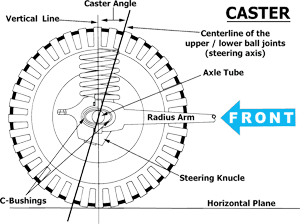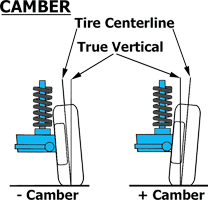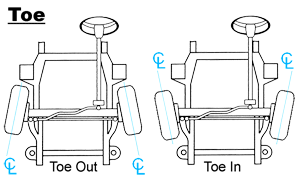Simple allignment terms explained.
Whenever you install a lift kit or change any suspension geometry its important to make sure your caster, camber and toe are in line with factory specs.
 |
Caster is the fore or aft slope of the steering axis. The steering axis is a line drawn through the upper and lower ball joints of the knuckle. Positive caster is when the bottom of the steering axis line is in front of the tire's contact patch. Zero caster is when the steering axis is at 0 degrees. Factory alignment specs for basically all vehicles call for a certain degree of positive (shown) caster. This ensures good stability, helps maintain straight-ahead direction and promotes steering wheel self-centering. |
 |
Camber is the inward or outward tilt of the front tires as viewed from the front. Inward tilt is negative, outward tilt is positive. Camber is used to distribute load across the entire tread. Improper camber makes the tire wear on one edge, and causes the vehicle to pull to the side that has the most positive camber. |
 |
Toe is the side-to-side difference in distance between the front and rear of the front tires. If the distance is closer at the front, it's called toe-in. If the difference is closer at the rear, it's called toe-out. |
Article Type:
How It Works
Category:
Suspension & Steering Tech












